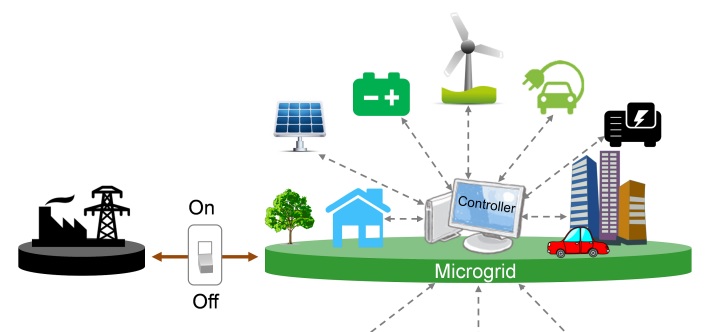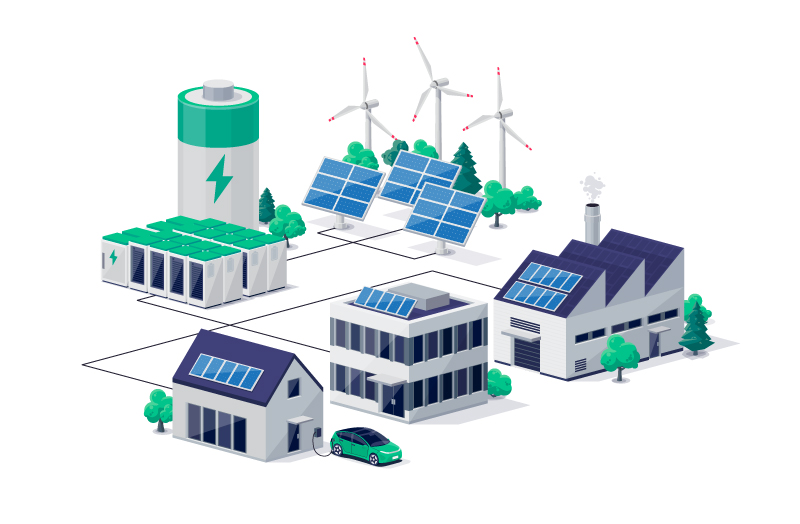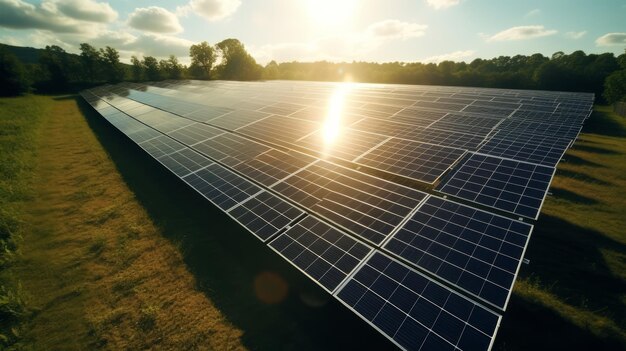
Microgrids: Building Resilient Local Energy Systems – Your Guide to Powering the Future
In a world increasingly prone to unpredictable weather events, natural disasters, and even cyber threats, the reliability of our energy supply has never been more critical. Traditional, centralized power grids, while powerful, have a fundamental vulnerability: if one major component fails, vast areas can be plunged into darkness.
Enter Microgrids – a revolutionary approach to energy that promises not just power, but resilient, reliable, and sustainable power, right where it’s needed most. Far from a futuristic concept, microgrids are already quietly safeguarding critical facilities, powering remote communities, and laying the groundwork for a more robust energy future.
This comprehensive guide will demystify microgrids, explaining what they are, how they work, why they’re so important, and the incredible benefits they offer for building truly resilient local energy systems.
What Exactly is a Microgrid? A Mini-Grid Explained
Imagine the vast, interconnected national power grid – a complex network of power plants, transmission lines, and substations that delivers electricity across huge distances. Now, imagine a mini-version of that grid, but designed to serve a smaller, localized area. That, in essence, is a microgrid.
A microgrid is a localized group of electricity sources and loads that typically operates connected to a traditional, centralized grid (the "macrogrid") but can disconnect and operate independently (in "island mode") during a power outage or disturbance.
Think of it like a highly intelligent, self-sufficient energy neighborhood. When the main power lines go down, this neighborhood can simply "unplug" from the unreliable outside world and keep its own lights on, thanks to its internal power sources.
Why Are Microgrids So Important Right Now? The Need for Resilience
The world is changing, and so are our energy needs and challenges. Here’s why microgrids are becoming an indispensable part of our energy future:
- Increasing Power Outages: Extreme weather events (hurricanes, wildfires, blizzards), aging infrastructure, and even cyberattacks are causing more frequent and longer power outages across the globe.
- Vulnerability of Centralized Grids: When the main grid fails, it often affects large regions. Critical facilities like hospitals, emergency services, and data centers can be severely impacted.
- Growing Demand for Reliable Power: Businesses and individuals alike rely on constant power for everything from communication to commerce.
- Rise of Renewable Energy: Solar panels and wind turbines are fantastic, but their output can be intermittent (no sun at night, no wind on calm days). Microgrids can integrate these sources with storage and other generators to ensure consistent power.
- Desire for Energy Independence: Communities and organizations want more control over their energy supply, reducing reliance on distant and sometimes fragile infrastructure.
Microgrids offer a direct solution to these challenges, providing a layer of protection and control that traditional grids simply cannot.
How Does a Microgrid Work? The Brains Behind the Power
A microgrid isn’t just a collection of generators; it’s a sophisticated, intelligent system. Here are its key components and how they work together:
1. Energy Generation Sources: The Power Producers
Microgrids are designed to be flexible, drawing power from various sources, often a mix of traditional and renewable:
- Renewable Energy:
- Solar Panels (Photovoltaics – PV): Convert sunlight directly into electricity. Often seen on rooftops or in ground-mounted arrays.
- Wind Turbines: Harness the power of wind to generate electricity.
- Traditional/Dispatchable Generators:
- Natural Gas Generators: Reliable and efficient, they can be quickly ramped up or down to meet demand.
- Diesel Generators: Often used as a backup or for remote locations where natural gas isn’t available.
- Combined Heat and Power (CHP): Generates electricity and captures waste heat for heating or cooling, making them highly efficient.
2. Energy Storage: The Battery Bank
- Batteries (e.g., Lithium-ion): These are crucial for microgrids, especially those relying heavily on renewables. They store excess electricity when generation is high (e.g., sunny midday) and release it when needed (e.g., at night or during peak demand).
- Flywheels or Supercapacitors: Other forms of fast-acting storage used for very quick bursts of power or grid stabilization.
3. Loads: The Energy Consumers
These are simply the buildings, devices, and equipment that consume the electricity generated by the microgrid. This could be anything from a hospital’s operating rooms to a university campus’s dorms and labs, or a residential neighborhood’s homes.
4. The "Brain": Control and Management System
This is the most critical component, making a microgrid "smart." It’s a sophisticated software and hardware system that constantly monitors:
- Power generation: How much electricity is being produced by each source.
- Energy storage levels: How much power is in the batteries.
- Energy demand (loads): How much electricity the consumers need.
- Grid connection status: Whether the main grid is available or if there’s an outage.
How it operates:
- Grid-Connected Mode: Most of the time, a microgrid operates connected to the main grid, buying power when it’s cheap and selling excess power back to the grid when it’s profitable.
- Island Mode (Disconnected): If the main grid experiences an outage, the control system quickly and seamlessly "islands" the microgrid. It disconnects from the main grid and uses its internal generation and storage to keep power flowing to its local loads. When the main grid is restored, the control system reconnects the microgrid smoothly.
- Load Management: The "brain" can also prioritize critical loads during island mode, ensuring essential services (like hospital ICUs) always have power, even if less critical areas (like parking lot lights) need to be temporarily shut down.
Key Benefits of Microgrids: Beyond Just Keeping the Lights On
The advantages of microgrids extend far beyond simply avoiding blackouts. They contribute to a more efficient, sustainable, and secure energy future:
1. Unmatched Reliability and Resilience
- Blackout Protection: This is the primary benefit. Microgrids can "island" themselves, ensuring continuous power supply to critical facilities and essential services during macrogrid failures.
- Faster Recovery: Even if a microgrid itself experiences a localized issue, it can often be restored much faster than a large, complex centralized grid.
- "Black Start" Capability: Many microgrids can restart themselves without external power, which is crucial after a complete system shutdown.
2. Enhanced Sustainability and Environmental Benefits
- Renewable Energy Integration: Microgrids are ideal for incorporating high percentages of solar, wind, and other clean energy sources, reducing reliance on fossil fuels.
- Reduced Carbon Emissions: By optimizing the use of renewables and efficient generators (like CHP), microgrids significantly lower greenhouse gas emissions.
- Local Generation: Producing power closer to where it’s consumed reduces transmission losses, making the system more efficient.
3. Cost Savings and Economic Benefits
- Peak Shaving: By using stored energy or internal generation during periods of high demand (when electricity from the main grid is most expensive), microgrids can significantly reduce utility bills.
- Demand Response: Microgrids can participate in utility programs, reducing their consumption during grid stress events and earning financial incentives.
- Energy Arbitrage: Buying power when it’s cheap and selling it back or using stored power when prices are high.
- Avoided Losses: Reduced transmission losses mean more efficient use of generated power.
4. Energy Independence and Security
- Decentralization: Shifts power generation away from vulnerable central points to local, distributed sources.
- Reduced Vulnerability: Lessens dependence on a single, potentially fragile grid infrastructure.
- Protection Against Cyber Threats: A localized system can be easier to secure against cyberattacks compared to a vast, interconnected grid.
5. Grid Modernization and Support
- Grid Stability: Microgrids can help stabilize the larger grid by providing ancillary services, like voltage support or frequency regulation.
- Reduced Strain: By generating power locally, microgrids can alleviate congestion and strain on existing transmission and distribution lines.
- Facilitating EV Integration: As electric vehicles become widespread, microgrids can provide localized charging infrastructure that doesn’t overwhelm the main grid.
Who Uses Microgrids? Real-World Applications
Microgrids are not just theoretical; they are being deployed across a wide range of sectors, demonstrating their versatility and value:
- Critical Facilities:
- Hospitals and Healthcare Campuses: Essential for maintaining life support, operating rooms, and critical patient care during outages.
- Data Centers: Ensure uninterrupted power for servers and data storage, preventing costly downtime.
- Emergency Service Hubs: Fire stations, police departments, and emergency operations centers need continuous power to respond to crises.
- University and Corporate Campuses:
- Provide reliable power for dorms, classrooms, research labs, and administrative buildings, ensuring educational and business continuity.
- Often integrate renewables and serve as living laboratories for energy research.
- Military Bases:
- Crucial for national security, ensuring operational readiness and resilience against attacks or natural disasters.
- Often prioritize energy independence.
- Remote Communities:
- Provide reliable and often cleaner power to areas far from the main grid, replacing costly and polluting diesel generators.
- Indigenous communities, islands, and rural outposts benefit greatly.
- Industrial Parks and Commercial Buildings:
- Protect manufacturing processes from costly interruptions and optimize energy consumption.
- Enable businesses to maintain operations even when the surrounding area loses power.
- Residential Developments and Community Microgrids:
- While less common on an individual home basis, entire neighborhoods or housing developments are being designed with shared microgrids to boost community resilience.
The Future of Energy is Local: Microgrids Paving the Way
Microgrids represent a fundamental shift in how we think about and manage our energy. They are a cornerstone of the broader movement towards distributed energy resources (DERs), which emphasizes smaller, localized power generation rather than large, centralized power plants.
As technology advances, microgrids will become even smarter, more efficient, and more affordable. They will integrate seamlessly with:
- Smart Home Devices: Allowing homes to optimize their energy use in real-time.
- Electric Vehicle (EV) Charging Infrastructure: Providing localized, resilient charging hubs.
- Artificial Intelligence (AI): For even more precise forecasting of energy demand and supply, optimizing performance.
Ultimately, microgrids aren’t just about avoiding blackouts; they are about empowering communities, organizations, and individuals with greater control over their energy destiny. They are a vital step towards a more robust, sustainable, and resilient energy landscape for everyone.
Conclusion: Powering Resilience, One Local Grid at a Time
The traditional energy grid has served us well, but its vulnerabilities are becoming increasingly apparent. Microgrids offer a powerful, practical solution, enabling us to build truly resilient local energy systems that can withstand disruptions, integrate clean power, and provide economic benefits.
By decentralizing power generation, leveraging smart technology, and embracing a mix of energy sources, microgrids are not just an alternative – they are an essential component of a secure, sustainable, and reliable energy future. Investing in microgrids today means investing in the uninterrupted power and peace of mind for tomorrow.



Post Comment